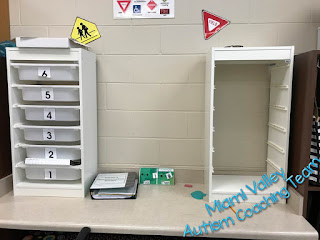Many of the teams we coach are concerned with their students' ability to remain focused and engaged in their learning. This week's Regulation Rendezvous will highlight strategies we have seen throughout the Miami Valley to increase student focus.
Sometimes desk reminders can be a way to nonverbally redirect student attention without disrupting the learning of other students.
 |
Taylor Ruef
Stevenson Elementary, Mad River |
Fidgets or other sensory equipment such as weighted shoulder or lap pads, vests, or wiggle seats can be helpful for students. At Stevenson Elementary, the teachers are able to check out various sensory items to trial with students.
 |
Emily Ottmar
Stevenson Elementary, Mad River
|
 |
Jennifer McGowan
Smith Middle School, Vandalia |
This flexible ruler is a great tactile fidget which offers students some input but minimal distractions.
Other students may need a foot fidget while they are working. Many classrooms use a Theraband or Bouncy Band on a student's chair. We have also seen desk pedals and a great PVC pipe foot swing for a high school student.
 |
Sandy Beck
Broadway Elementary, Tipp City |
 |
Joel Derge
Tipp City High School, Tipp City |
All students have different needs when it comes to how often they need to move or wiggle or if they do better sitting or standing. Flexible seating is becoming increasingly popular in a variety of classrooms. When established in a purposeful, structured way this support can have a huge impact! We loved the flexible seating options in Courtney Young's Kindergarten class in Beavercreek. Courtney's seating options included stools, therapy balls, chairs, wiggle seats, bean bag chairs, floor cushions, Hokki stools, and a standing table.
 |
Courtney Youngs
Fairbrook Elementary, Beavercreek |
Other examples of flexible seating we have seen include a great rocking chair that looks very similar to typical chairs and a podium used as a standing desk in a 2nd grade classroom.
 |
Sarah Brown
Edison Elementary, Dayton Public Schools |
 |
Kim Hampton
Broadway Elementary, Tipp City |
Many students benefit from an office space or "homebase" where they can complete assignments especially when feeling overwhelmed. Several of the teachers that we have seen effectively use this approach limit sensory overload through use of dim lighting, and through reducing visual clutter in the work space.
 |
Sandy Beck
Broadway Elementary, Tipp City |
 |
Jennifer Jette
Vandalia-Butler High School, Vandalia |
 |
Laura Brown
Perrin Woods Elementary, Springfield |
 |
Rachel Hatton
Normandy Elementary, Centerville
|
 |
Tabitha Eaton
Main Elementary, Beavercreek

|
Visual distractions can also be limited through the use of portable dividers.
 |
Marissa Calhoun
Fairbrook Elementary, Beavercreek |
 |
Brittany Bush
Spinning Hills Middle School, Mad River |
 |
Kendall Koehler
Normandy Elementary, Centerville |
Another way to increase student engagement and focus is by incorporating multi-sensory movement activities before starting their work.
 |
Sandy Beck
Broadway Elementary, Tipp City |
 |
Tina Snyder
Miami Valley ESC |






































































